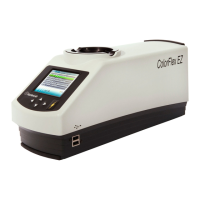
Do you have a question about the HunterLab ColorFlex EZ and is the answer not in the manual?
| Brand | HunterLab |
|---|---|
| Model | ColorFlex EZ |
| Category | Measuring Instruments |
| Language | English |
Describes different types of safety statements and their meaning.
Lists included accessories such as calibration tiles, cables, and manuals.
Provides step-by-step instructions for connecting and setting up the instrument.
Explains the function of the five buttons and the LCD screen layout.
Describes navigation through the main menu and prompts for operations.
Details how to view instrument model, serial number, and firmware version.
Outlines the basic steps for performing a measurement.
Explains the procedure for standardizing the instrument using calibration tiles.
Guides through taking individual sample readings, including setup selection.
Explains the concepts of product standard, sample, and tolerance settings.
Describes how to create and manage product-specific operating parameters.
Details how to enter a descriptive name for a product setup.
Explains the four types of standards: Working, Physical, Numeric, Hitch.
How to average multiple readings for a single measurement.
How to configure displayed measurement data views.
Options for displaying measurement data: Absolute and Difference.
Displays raw reflectance values for each wavelength.
Shows reflectance difference between standard and sample per wavelength.
Graphs raw reflectance values versus wavelength.
Displays sample's location in color space relative to the standard.
How to choose illuminant/observer combination for color values.
How to select the desired color scale for measurements.
How to choose the color index for measurement analysis.
How to configure CMC/Shade Sort parameters for dEc or SSN indices.
How to read or enter standard values for Physical, Numeric, Hitch types.
How to set acceptable limits for color differences.
How to enable/disable automatic standard search feature.
How to select the display language for screens and prompts.
Configuration for screen angle, backlight, contrast, and dimming.
Adjusts screen text orientation for better readability.
Controls the brightness level of the LCD backlight.
Adjusts the contrast of the display for better visibility.
Sets the time before the LCD backlight automatically dims.
Sets the time before the display automatically turns off.
Option to lock product setups to prevent modification.
Configures whether measurements are saved automatically or manually.
Sets the time before the instrument prompts for re-standardization.
Feature to find the closest standard to a sample read.
Allows setting the current date and time on the instrument.
Restores all product setups to their default factory values.
Outputs all product setup parameters via USB.
Outputs parameters for a single selected product setup via USB.
Copies all product setups from one instrument to another.
How to save measurements to a USB drive.
Steps to take and average multiple readings for a single measurement.
How to view, print, and delete stored measurements.
Erases all stored measurements from the instrument's memory.
Outputs all saved measurements to a device via USB.
Allows the user to view and scroll through saved readings.
Views saved readings filtered by a specific product setup.
Guidelines for choosing representative samples for measurement.
Instructions for preparing samples according to standard methods.
How to present samples to the instrument for consistent measurements.
Minimizing directionality effects by averaging rotated readings.
Ensuring consistent backings for non-opaque sample measurements.
Handling translucent samples to ensure accurate color readings.
Instructions for cleaning the exterior surfaces of the instrument.
How to care for and clean calibration tiles and black glass.
Information on arranging for professional lamp replacement.
How to run tests to verify instrument performance.
Tests the consistency of readings using the white calibration tile.
Compares instrument memory values to factory values for the green tile.
Displays a graph of sample and monitor channels for analysis.
Runs subsystem communication tests and displays firmware versions.
Recommended temperature, humidity, and environmental ranges.
Details weight, dimensions, and communication interface.
Describes light source, lamp life, geometry, and viewing parameters.
Provides data on spectral range, bandwidth, resolution, and agreement.
Lists available data views, illuminants, observers, color scales, and indices.
Details the connection and function of the optional thermal printer.
Describes the optional flexible keyboard for data entry.
Explains the optional scanner for reading bar codes for ID tags.
How to transfer data and setups using a USB flash drive.
Device for holding samples flat at the measurement port.
Device for measuring yarn skeins.
Different sized openings to change the view area at the reflectance port.
A glass-covered insert to protect the instrument from particles.
Port insert with a 420-nm filter to prevent UV illumination.
Set for holding powders, liquids, and granules with specific components.
Special insert to hold the sample cup in position at the measurement port.
Opaque cover to exclude external light from the sample cup.
Plastic ring and ceramic disk for sample cups to exclude light.
Windows program for numerical calculations and graphical data representation.